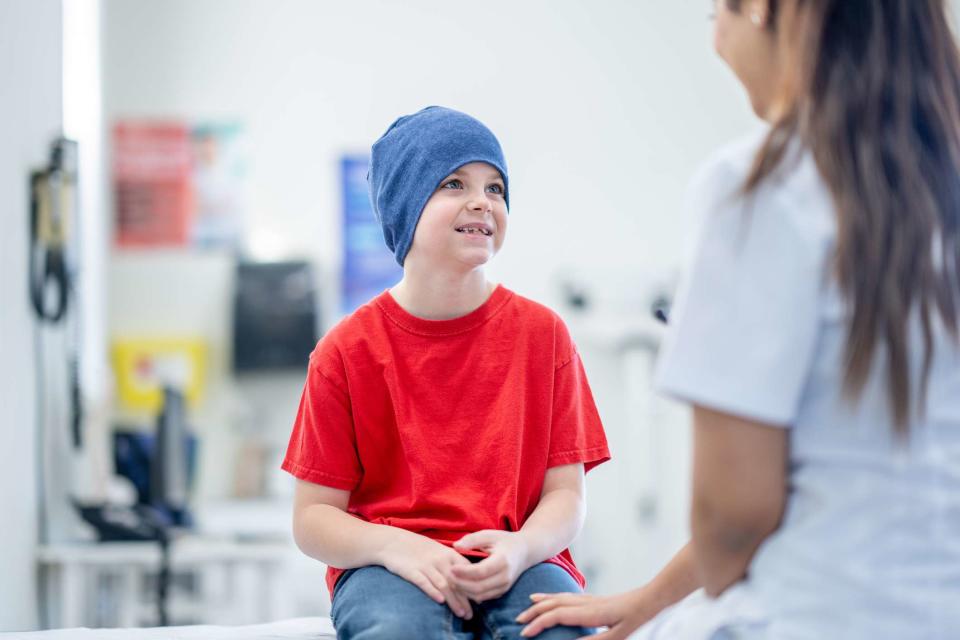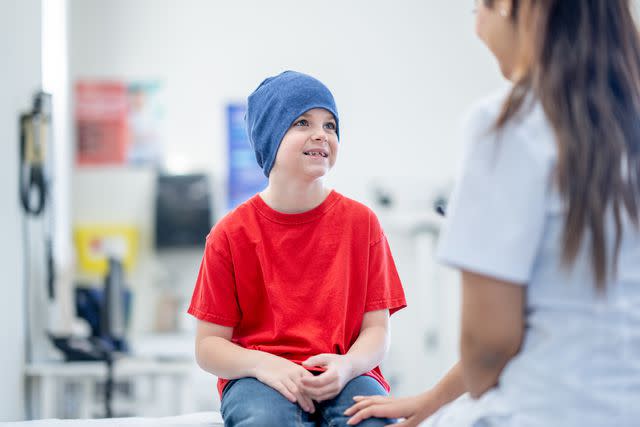Success of Rhabdomyosarcoma Treatment in Children
Including Rarer Types of RMS Disease in Adults

FatCamera / Getty Images
Medically reviewed by Doru Paul, MD
Rhabdomyosarcoma is a kind of sarcoma—cancer of soft tissue, connective tissue, or bone. This includes tendons, cartilage, and muscle. It typically starts in muscles attached to bones but can occur in various places in the body. Rhabdomyosarcoma is the most common kind of sarcoma in children.
Knowing the symptoms of rhabdomyosarcoma can help with early detection and treatment, which is important before the cancer spreads. Read on to find out more about what happens after diagnosis, what treatment entails, survival factors, and more.

FatCamera / Getty Images
Receiving a Rhabdomyosarcoma Diagnosis
Soft tissue sarcomas make up 7% to 8% of all childhood cancers. For most kids with the disease, the cause is not known, but it occurs more often in some rare inherited conditions.
Symptoms can include:
Swelling or a lump that doesn't go away
Headaches
Bulging eyes
Constipation
Nosebleeds or vaginal/rectal bleeding
While these cancers can be painless, especially in the beginning, sometimes they can cause pain, depending on where the tumor is and what it's pressing on. If the tumor is near the ear, it can press on the eardrum and cause pain like earaches; in the abdomen, it can cause stomach pain; and if the tumor is in the bladder or urinary tract, it can cause painful urination.
These cancers can occur anywhere in the body. Most commonly (about 40% of diagnoses), the cancer is found in the head and neck area, including near the membranes covering the brain, the eye socket, or other sites. About 30% of cases are in the urinary or reproductive organs. The arm or leg comprises about 15% of cases. Other locations are seen in the rest.
Diagnostic Tests
In order to diagnose rhabdomyosarcoma, various tests will be done, including:
Biopsy: A small amount of tissue from the tumor will be removed to be examined microscopically.
Immunocytochemistry tests: These are special stains used in the lab on the tissue samples that help provide information about the tissue.
Genetic tests of the biopsied tissue: These tests help determine if there are any changes to the chromosomes or identify the alveolar subtype.
Imaging tests: X-rays, computed tomography (CT), magnetic resonance imaging (MRI), or positron-emission tomography (PET) can help show if the cancer has spread to other areas of the body.
Once diagnosed, your child will typically have a multidisciplinary team of many professionals, including child life specialists, nutritionists, orthopedic surgeons, pediatric oncologists (cancer specialists), occupational therapists and physical therapists, and counselors.
Get to know all of them when you can—they are there to help you in various ways and are often a wealth of knowledge and resources.
Staging
Treatment for cancer depends largely on the staging of the cancer. For childhood rhabdomyosarcoma, this is done in three parts: staging, grouping, and risk group, as follows:
TNM staging system: Stages 1, 2, 3, and 4 are assigned based on tumor size, where it is in the body, and whether it has spread to other areas of the body.
Clinical grouping system: Groups 1, 2, 3, and 4 are assigned based on whether the cancer has spread and if it was removed completely by surgery.
Risk group: Based on the staging and grouping, is assigned as low-risk, intermediate-risk, and high-risk.
Types of Rhabdomyosarcoma in Children
Rhabdomyosarcoma is not a single diagnosis; there are multiple types of disease. The specific type determines the kind of treatment a person will receive.
The four main types of rhabdomyosarcoma in children are:
Embryonal: This most common type of rhabdomyosarcoma is often in the head/neck area or genital/urinary organs but can occur anywhere.
Alveolar: This typically occurs in the arms, legs, chest, abdomen, genitals, or anal area.
Spindle cell/sclerosing: Spindle cell usually occurs in the testicular area; there are subtypes, one of which occurs in infants in the trunk area of the body, and the other can occur at any age, usually in the head and neck area.
Pleomorphic: This is the least common type in kids.
The type of rhabdomyosarcoma can affect the prognosis, in addition to the cancer stage and whether it is low-risk or high-risk. Some types of rhabdomyosarcoma are more aggressive than others, are more resistant to treatment, and are more likely to recur.
Talk with your treatment team about the kind of cancer your child has and what it means for treatment and prognosis.
Rhabdomyosarcoma in Adults
The type and location of rhabdomyosarcoma vary by age group, although it can occur anywhere in the body. Children and young adolescents tend to have the embryonal type, and it is more likely to involve the head and neck. In adolescents, the alveolar type is common, occurring often in the extremities. The pleomorphic type typically develops in the extremities and is chiefly seen in adults.
While rhabdomyosarcoma can occur in adults, it is very rare. In adults, it's commonly found in the extremities, followed by the trunk, genitourinary tract, head, and neck. There are challenges in making a correct diagnosis in adults, and the prognosis is generally poor, especially when compared with children.
After Diagnosis: Rhabdomyosarcoma Treatment Plan
Treatment for rhabdomyosarcoma can vary, depending on the type, subgroup, and stage of cancer, the child's overall health, possible side effects, and preferences of the child and family.
Talking with your child's treatment team about which treatments may be possible and the effects of each one can help you come to an informed, empowered, and shared decision about treatment.
Common treatments for rhabdomyosarcoma include:
Surgery: This is typically the first treatment—to remove the tumor and surrounding tissue. After surgery, chemotherapy is needed. Sometimes chemotherapy, radiation therapy, or both are given before surgery to shrink the tumor.
Chemotherapy: Commonly used drugs include Oncovin (vincristine), Cosmegen (dactinomycin), and Cytoxan (cyclophosphamide). The combination of these is called VAC. They are given by intravenous injection. Chemotherapy treatment will vary depending on whether the rhabdomyosarcoma is categorized as low risk, intermediate risk, or high risk.
Radiation therapy: External beam radiation therapy uses a high-energy beam from a machine to target the tumor. Sometimes, radiation therapy is given via an implant (internal radiation therapy or brachytherapy).
Targeted therapy and immunotherapy are being studied for this kind of cancer in clinical trials. Targeted therapy uses drugs or other substances to attack specific characteristics of cancer cells, which may cause less damage to healthy cells. Immunotherapy is a treatment that utilizes the person's own immune system in fighting the cancer.
Late effects from childhood cancer treatment (radiation therapy and chemotherapy) are a possibility. Late effects are side effects or health issues that can arise months to years after childhood cancer treatment is over. They can vary depending on the treatment, dosage, frequency, and the person's general health.
Late effects can include:
Issues with growth and development
Altered learning, memory, and thinking
Issues with social and psychological adjustment
Problems with organs, tissues, and body functions
Second cancers
Rhabdomyosarcoma Clinical Trial Enrollment
Overall, childhood cancer is not common. Treatment plans can be hard to construct unless there is sufficient evidence to know what’s been effective in other children. Nearly all children with rhabdomyosarcoma are treated as part of a clinical trial. Clinical trials test new treatment approaches, like a new drug or combination of drugs.
Participation in clinical trials is voluntary, and if you choose not to enroll your child, you will be given the standard of care for your child’s cancer—the best-known treatment available based on previous clinical trials. If you enroll your child in a clinical trial, they will be monitored closely for their health and safety, and you can leave the trial at any time.
Clinical trials may not be available at every hospital or cancer center, so if you’re interested in participating in one, talk with your treatment team to see if your child qualifies for a clinical trial.
Rhabdomyosarcoma, Survival, and Determining Factors
It’s important to remember that statistics are just that—statistics. They don’t tell the whole story. They just give numbers, not personal factors or individual circumstances. They just describe trends of survival and should not be taken as a definite indicator of mortality or chance of survival for an individual.
Rhabdomyosarcoma can be put into remission, which means there is no detectable disease. For many individuals, this is permanent. However, there is no guarantee that it definitely won't come back. In some people, it does return, or recur, and thus is not "cured."
For children 5 and younger, the overall five-year survival rate is 71%. For those ages 15 to 19, the overall five-year survival rate is 54%.
Survival rates for children and teens with rhabdomyosarcoma vary greatly and depend on the stage and risk group of the cancer, the general health of the child, and how well the treatment works.
For those with low-risk rhabdomyosarcoma, the five-year relative survival rate can range from 70% to 90%; for those with intermediate-risk disease, the five-year survival rate can range from 50% to 70%; and for the high-risk disease group, which means the disease has spread throughout the body, five-year survival rates range from 20% to 30%.
Talk with your child’s care team for specifics regarding your child's stage and risk, what they mean for their survival, and how the treatment is working.
Additional Support for Rhabdomyosarcoma Patients
A cancer diagnosis can be unexpected, scary, and/or stressful—but you don’t have to go through it alone. Getting support is important to help manage and relieve stress, provide emotional and practical support and ensure that you’re getting the best and most appropriate care. Additional support can include:
Palliative care (directed at relieving symptoms rather than a cure)
Support groups for patients and/or caregivers
Nutritional support
Financial support like grants or aid
Education about the disease, its treatment, and its effects
Referrals to outside resources or community organizations like transportation help or lodging assistance
Summary
Rhabdomyosarcoma is the most common sarcoma in children. It starts in the soft tissues, and while it can occur at any age, it’s usually diagnosed in childhood. Treatment can depend on the specifics of the cancer, as well as the individual characteristics of the child, but it usually consists of surgery, followed by chemotherapy, and perhaps radiation.
For cancer that has not spread throughout the body, long-term survival rates are very good—more than 70% of children with this cancer have a good prognosis.
Questions about rhabdomyosarcoma or your child’s condition should be directed toward their treatment team. They know your child and their diagnostic specifics best and can provide you with personalized information to help you understand the situation and help you and your family make informed choices that are best for you.

